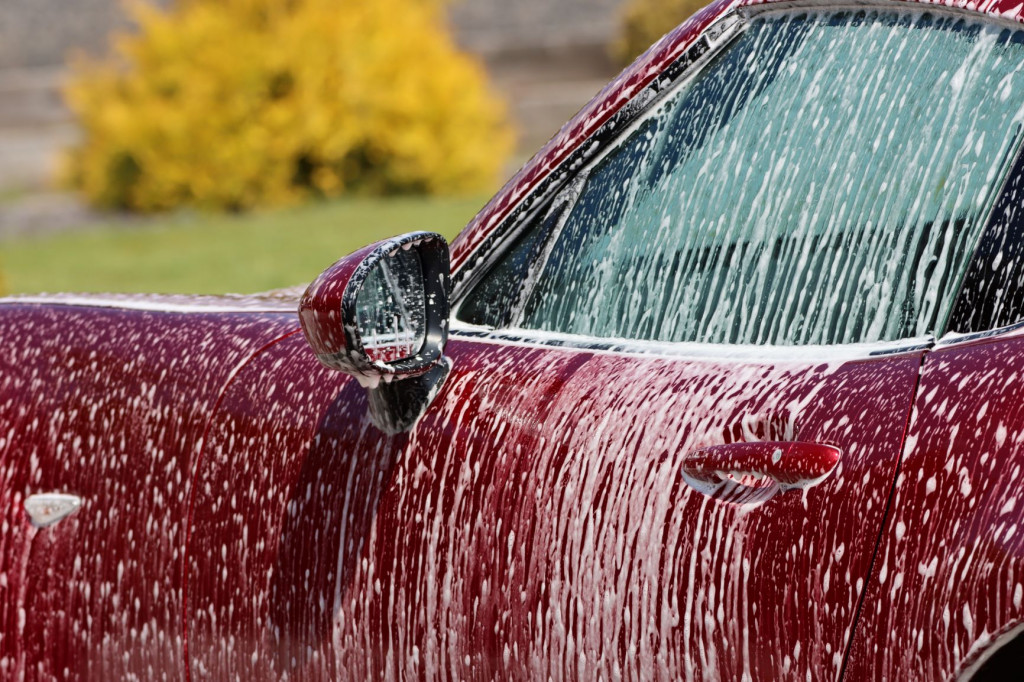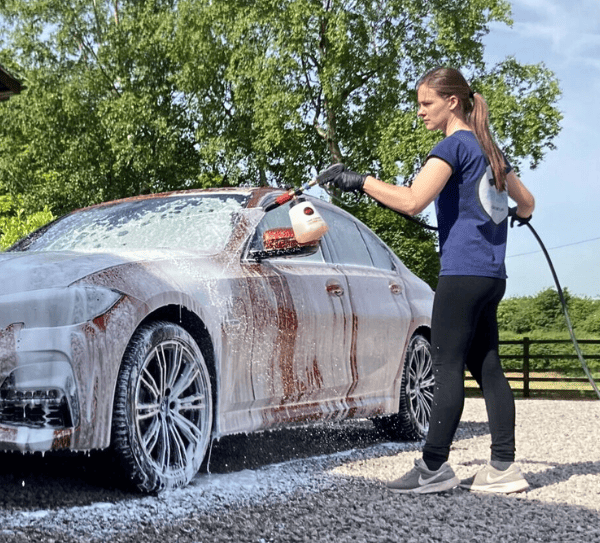Traffic film removers can be a really effective product for cleaning filthy vehicles. Often they’re either applied in a snow foam, or used in a wash bucket. But how safe are they for your car’s paintwork.
In this article, I’ll take you through what traffic film removers (TFR), will do to your car’s paintwork and waxes/sealants, and how to use them safely. So let’s get started.
The Quick Answer
Traffic film removers should not damage the paint on your car as long as they’re used at a low concentration, are not allowed to dry on the surface and used infrequently.
TFRs will strip waxes and sealants though, so don’t use them during a maintenance wash. Only use them when you plan to apply a wax or sealant following the wash process.
Traffic Film Removers are Potent
It’s really important to understand just how potent traffic film removers (TFRs) are before ever using them on your vehicle. TFRs are safe on a car’s paint, but only when used properly.
TFRs will need diluting, when used in a snow foam cannon or pump sprayer to pre-wash your car. This is because they are super strong. If you use them at high concentrations, then you’re guaranteed to run into issues.
Of course, this potency is what makes them such effective cleaners. But it also means you need to take caution whenever you are planning on using a TFR on a vehicle.
It’s not recommended to use these products frequently either. A TFR is okay to use every now and again but should not be used as part of a routine. I see TFRs as a tool for super dirty cars, but try to use milder products when possible.
They Will Strip Waxes and Sealants
Traffic film removers are very effective at stripping waxes and sealants. This is primarily due to their pH.
You may often see that a lot of car shampoos/ snow foams are described as “pH neutral”. This means that they won’t break down the waxes and sealants on your car’s clear coat. So they’re great for maintenance washes between waxing.
Traffic film removers have a pH between 12-14, so they are very effective at breaking down waxes so they are washed away from the surface. Often, when diluted, the pH will be more like 10-12, but it still can have this wax-stripping effect.
Sometimes, this can be really useful. Stripping old waxes and sealants is essential before performing any paint correction (polishing), or applying a new sealant. So they can be a useful product to have.
But of course, if you’re not planning on polishing or reapplying paint protection, then you’ll want to steer clear of using a TFR. Even if you use a dilute concentration, the wax can start to breakdown. And if you use it too diluted, then it won’t have any cleaning ability.
They Can Cause Staining
Traffic film removers also have the potential to actually stain your car’s paint. Now this won’t happen if you use them properly. But it’s really important to be careful when using a TFR or you can cause permanent damage to your car.
It usually only occurs if you let it dry on the surface. So never use it in direct sunlight, or on a hot day.
If you’re using a TFR as a snow foam alternative that strips wax, then you really need to be careful with the dwell time. Use a much shorter dwell time than you would for a normal snow foam, because you really can’t let it dry on the surface. A 2-4 minute dwell time is plenty if you’re using it as a pre-wash.
They Can Accelerate Corrosion and Rusting
TFRs also have the potential to accelerate rusting and corrosion processes. These can be an issue on the paint, but they are more of an issue for the wheels, undercarriage and trim.
This is a particular problem with caustic TFRs. Some TFRs are non-caustic which makes this less of an issue.
You shouldn’t use a traffic film remover as part of a routine for washing your car frequently. Instead, you should only use TFRs for specific purposes e.g. stripping wax or cleaning very dirty vehicles. And you shouldn’t use them often, or you can increase the risk of rusting occurring.
When to Use a TFR
So when should you actually use a traffic film remover. Personally, I use them in a couple of different situations.
- To strip stubborn waxes and sealants
- To clean absolutely filthy vehicles
Like I mentioned before, TFRs are alkaline, so they’ll strip old waxes and sealants. Sometimes I use a TFR as part of a pre-wash, and also in the wash bucket to break down the wax a bit faster. This can be an effective way at removing paint protection before you apply a new layer, or degreasing the surface before you polish or compound.
Sometimes, normal snow foams and car shampoos just isn’t as effective at cleaning absolutely filthy cars. Instead, you need something with a bit more potency.
That’s why I sometimes bring the TFR out to clean really neglected cars that haven’t been washed in months, and sometimes even years. Because they are so potent, they do a great job at breaking down the grime that has accumulated.
When used properly, traffic film removers can be a really useful product.

How to Use a TFR Safely
Okay then, now we know when you should actually use a TFR, and some of the risks to consider, how do you actually use one without any of the negative effects.
There are two main things to think about:
- Concentration
- Dwell time
Like I said earlier, traffic film removers are very concentrated and potent. So they should always be diluted before using them. The exact concentration really depends on which TFR you’re using and you should follow the manufacturer’s instructions.
However, as a general rule, you don’t want to use a TFR at a higher concentration than 1-2%. Below this concentration, the risks of staining, corrosion and rusting are quite low. The cleaning power will also be good at this concentration.
So don’t think that you need to use a really high concentration to clean a filthy car.
Being conscious of the dwell time is also vital. This simply refers to how long the TFR is on the surface of you’re car.
Of course, the specifics do depend on the TFR you’re using, and the concentration. However, to be on the safe side, don’t let a traffic film remover stay on the paint for longer than a few minutes.
To keep on top of this, set a timer when you use it as a pre-wash in a snow foam cannon. Or if you’re using it in your wash bucket, rinse the panel down immediately after washing it. Don’t wait until you’ve washed the entire car before rinsing or you risk leaving it on the surface for too long.
Check out this complete guide to washing your car without causing scratches.
Thanks for reading! I hope you’ve found this article helpful. Don’t forget to check out the rest of the website to learn more about car washing and detailing.

